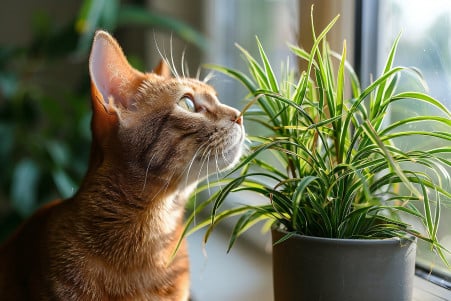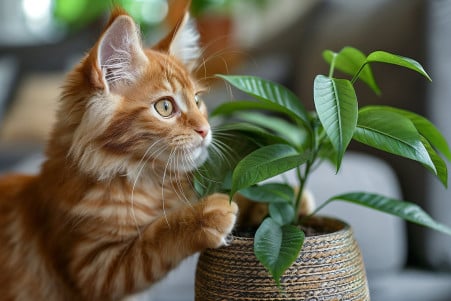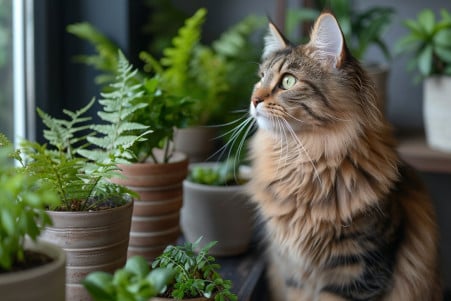Can Cats Eat Bromeliads? Safe Houseplants for Pet Owners
8 March 2024 • Updated 7 March 2024

Bromeliads are beautiful plants that can add a pop of color to any home, but are they safe to have around your cats? Luckily, bromeliads are non-toxic to cats, so they are safe to keep in your home.
That said, if your cat eats a large amount of a bromeliad, they may experience some minor digestive issues. Still, bromeliads are not considered a danger to cats, and you should just be sure to watch your pet for any signs of unusual behavior after they’ve eaten one.
By looking at information from both veterinarians and plant experts, we’ll give you a complete picture of bromeliads and their effect on cats. We’ll look at both the science behind the plants and their impact on animal health so you can be sure to create a safe and colorful indoor space for your inquisitive feline friends.
Are bromeliads toxic to cats?
Understanding Whether Bromeliads Are Safe for Cats
Bromeliads are a large family of plants that are known for their unique shapes and bright colors. They can grow in a variety of conditions, from soil to the air.
According to PlantCareToday, bromeliads are non-toxic to cats because they don’t contain any compounds that are toxic to cats. The ASPCA also lists bromeliads as safe for cats, although it notes that cats may experience some minor gastrointestinal upset if they eat any part of the plant.
The bottom line from experts is that bromeliads are safe for cats. However, it’s important to think about the entire environment in which the plant is being kept. For example, if bromeliads are being treated with fertilizers that contain copper or zinc, these can be toxic to cats if they are ingested in large amounts.
This means that even a non-toxic plant like a bromeliad can be a concern. This is why Catster recommends keeping bromeliads out of the way of cats to prevent them from eating the plants and to prevent the plants from being damaged.
Because cats are naturally curious, it’s important to create an environment that meets their needs while also keeping them safe. This may involve providing other options to discourage cats from eating plants.
Why Do Cats Eat Plants? A Look at the Science
So why do cats eat plants? While there’s no definitive answer, a report by Vetstreet suggests that cats may eat plants as a way to self-medicate to alleviate gastrointestinal distress or to induce vomiting to get rid of something in their system that they can’t digest.
Other possibilities are that cats are looking for a certain texture or taste that plants provide, or they are chewing on plants as a way to relieve stress or because they have an oral fixation.
While bromeliads are safe for cats, other plants can be toxic. According to Preventive Vet, the toxicity and symptoms of plant poisoning depend on the plant and the amount that the cat ingests. This is why it’s important to be able to tell the difference between bromeliads and other common houseplants.
In addition to making sure that your cat’s environment is full of cat-safe plants, you can also help prevent your cat from eating your plants by providing alternative activities. For example, you can offer your cat enrichment items like food puzzles or safe toys for chewing.
This way, you can redirect your cat’s behavior and meet their needs in a way that’s safe for them. By understanding your cat’s needs and providing for them, you can ensure that your cat and your houseplants can coexist in peace.
How to Tell If Your Cat Has Been Poisoned by a Plant
When it comes to keeping our cats safe, it’s important to know the signs of plant poisoning. According to The Healthy Pet Club, symptoms of plant poisoning in cats can include vomiting, diarrhea, drooling, tremors, difficulty breathing, and lethargy.
If you think your cat has eaten a poisonous plant, PetMD recommends removing any plant material from your cat’s mouth and environment immediately, noting the time of ingestion, and calling your vet or an animal poison control hotline.
Veterinarians may treat plant poisoning by inducing vomiting or giving the cat activated charcoal to absorb the toxins in the stomach. According to PetMD, mild cases can be treated on an outpatient basis, but severe cases may require hospitalization for intravenous fluids and blood work to check for organ damage.
To avoid plant-related health problems, it’s important to create a cat-friendly environment that doesn’t include any poisonous plants. By making sure that your indoor and outdoor gardens only include non-toxic plants, you can make sure that your cat can safely explore and be curious without the risk of poisoning.
What This Means for Cats and Plant Chewing
Even though cats are obligate carnivores, they may still eat plants from time to time. This behavior can be driven by a combination of nutritional and psychological factors.
According to the Clinical Nutrition Service at Cummings School, cats have specific dietary needs because they are obligate carnivores, and one of the most important is the requirement for certain amino acids, including taurine and arginine, which are found in animal proteins. Cats may eat plants if they are lacking in these nutrients.
While cats may not be seeking out bromeliads specifically, PetMD explains that a well-balanced diet is important for cats and can help deter them from eating plants. In addition, BeChewy explains that psychological and behavioral factors can also play a role. Cats may eat plants out of boredom or to satisfy their natural curiosity.
To help prevent your cat from eating plants, make sure that their diet is nutritionally complete and balanced, and meets the standards set by the AAFCO, which are listed on cat food packaging.
A diet that is complete and balanced in terms of the nutrients it provides, including the right amounts of protein, fat, and carbohydrates, can help ensure that your cat is healthy and may also help prevent them from eating your houseplants.
By ensuring that your cat’s diet is nutritionally complete, you can help prevent them from eating plants to supplement their diet and ensure that both your cat and your plants are healthy.
Creating a Cat-Friendly Environment
One of the best ways to avoid boredom and the unwanted behaviors that come with it is to make sure that your cat has a stimulating environment. Battersea Dogs & Cats Home explains that a calm and stable home meets a cat’s basic needs, which means that environmental and social stimulation can be prioritized.
Puzzle feeders, for example, encourage natural foraging behavior and can help reduce a cat’s interest in houseplants. To make sure that your cat is safe and stimulated, you can also add cat-friendly plants like cat grass or valerian, which can give cats that are attracted to the texture or movement of plants like bromeliads a safe alternative.
The Drake Center notes that environmental enrichment can help reduce stress-related behaviors like plant chewing. By providing vertical spaces for climbing, hiding spaces for rest, and interactive toys for play, you can help your cat meet their need for exploration and express their natural behaviors in a safe and healthy way.
As you arrange your home, make sure that plants like bromeliads are either out of reach or that you substitute them with a safer alternative. This will help ensure that your pets are safe and that your home continues to be a place of balance and beauty that everyone can appreciate.
Cultivating Accord: Bromeliads, Cats, and Thoughtful Coexistence
In conclusion, bromeliads are a standout choice for cat-friendly, pet-safe plants. These tropical plants are non-toxic to cats, which is great news for cat owners who want to bring some of the tropics into their homes.
It also means that cat owners can rest easy knowing their pets can coexist with these beautiful plants. That said, while the risk is low, it’s also worth mentioning that some cats may experience mild gastrointestinal upset if they eat plants.
This exploration of bromeliads and cats highlights the importance of being a responsible pet owner. Part of that responsibility is maintaining a safe environment for our pets, which includes being mindful of the plants we bring into our homes. By choosing non-toxic plants like bromeliads, cat owners can enjoy the best of both worlds, bringing the outdoors in while keeping their pets safe.
With that in mind, let’s work to create a home where plants and pets can coexist in a way that benefits both without putting either at risk. That means making informed decisions and taking a nurturing approach to the shared spaces of our plant-loving cats and ourselves.


